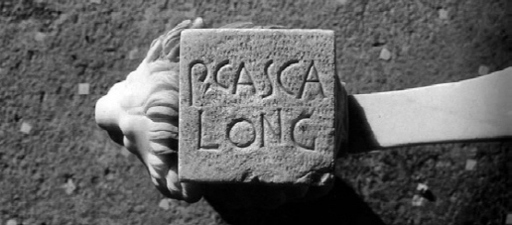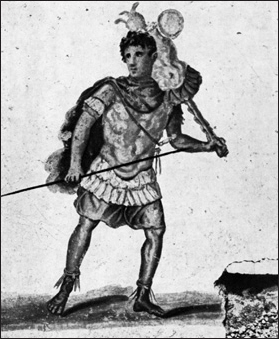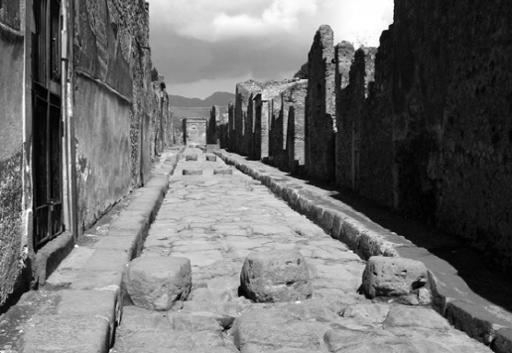Pompeii (10 page)
Authors: Mary Beard

The fact is that Pompeii existed very much in the penumbra of the city of Rome, and the history, literature, culture and people of the capital were embedded in the life and fabric of the small town, in sometimes surprising ways. If part of Mummius’ booty from the sack of Corinth ended up in the town, so too did at least one part of the property of one of the assassins of Julius Caesar. Discovered in the garden of a small house is a magnificent marble table support, with sculpted lions’ heads, inscribed as being the property of Publius Casca Longus (Ill. 17). This is almost certainly the man who was the first to put his dagger into the dictator, and it may be that the house was owned by one of his descendants. But it is much more likely (particularly given the house’s small size) that this was not an heirloom, but part of the property of Longus and the other guilty parties, auctioned off by the future emperor Augustus, who was Caesar’s great-nephew, adopted son and heir, after the assassination. However it found its way to Pompeii, it was presumably – like the Etruscan column – a curious historical talking point for the house’s visitors.
More generally, people from Rome came to Pompeii for business or pleasure. A group of four tombstones commemorating soldiers from the praetorian guard has recently been found in one of the Pompeian cemeteries, adding to half a dozen praetorians known from the ‘signatures’ they left in graffiti on the walls. Some were in relatively senior ranks; one of the dead was a young recruit, who at the age of twenty had served just two years. We can only guess at what they were doing in Pompeii – perhaps, like Clemens, on missions from the emperor, perhaps taking time off from guard duty on members of the imperial family staying in the area, perhaps even accompanying the emperor on a ‘royal visit’ to Pompeii itself.
In fact much scholarly energy has recently gone into re-creating the details of a visit by Nero and Poppaea in 64 CE, soon after the major earthquake and when Nero is known to have performed on the stage at Naples. It is, of course, possible that the imperial couple did make a visit, but the evidence for it is predictably much less firm than is usually admitted. The strongest indication is a couple of scrawled pieces of graffiti from inside one of the large houses in the town. Not easy to decipher or interpret, they
may
refer to gifts of jewels and gold to Venus by the imperial couple, and possibly a visit to Venus’ temple by ‘Caesar’ (that is, Nero) – even though, inconveniently for this interpretation, the temple of Venus, if we have identified it correctly, was in ruins at this point. All the same, this is much better evidence for Nero’s links with Pompeii than the paintings discovered in a building with an elaborate series of dining rooms, recently discovered at Moregine just outside Pompeii. Starting from the observation that a painting of Apollo on its walls looks distinctly like the emperor himself (Plate 3), archaeologists have claimed that this was the staging post, or temporary imperial residence, where Nero stayed on his visit to the town. This is a fantasy worthy of the most inventive eighteenth-century antiquarian.

17. What is the connection between Pompeii and the assassination of Julius Caesar in 44 BCE? The name of one of Caesar’s killers is inscribed on this table support, found in a small house in the town. The most likely explanation is that it ended up in Pompeii when the possessions of the guilty parties were auctioned off in Rome.
Just how canny we have to be in interpreting this kind of evidence is illustrated by another graffito. It reads, in Latin:
Cucuta a rationibus Neronis
. The position of
a rationibus
is roughly the equivalent of the English ‘accountant’ or ‘bookkeeper’. So this has been seen as a simple signature of ‘Cucuta Nero’s accountant’, writing his name on a wall, perhaps while accompanying his master on the visit to Pompeii. But this might be to miss the joke. For
cucuta
(or more regularly
cicuta
) is the Latin word for ‘poison’. This is much more plausibly a satirical squib at Nero’s expense than the autograph of a man with a slightly odd name. ‘Poison is Nero’s accountant’ looks like a joking allusion to those accusations which claimed that, in his financial difficulties, Nero put people to death to get his hands on their money. Someone in Pompeii was up with this kind of imperial gossip.

18. On the outside wall of a Pompeian fullery were paintings of two of the founders of Rome. Here Romulus, carrying his defeated enemy’s suit of armour, matched another which depicted Aeneas carrying his father out of Troy. Both were based on sculptures which stood in the Pompeian Forum – which were in turn based on sculptures in Rome itself.
But for a visitor in 79 CE, the most striking aspect of the connections between Rome and Pompeii would have been the various ways in which the fabric of the town, its buildings and art, replicated or reflected the concerns or even the very architecture of the capital. These ranged from the layout of the Forum, with its temple of Jupiter, Juno and Minerva standing at one end as a symbol of ‘Romanness’, through a couple of sacred buildings dedicated to the religious cult of the emperors, to self-conscious copying of celebrated Roman monuments. Outside one of the largest buildings in the Forum, the Building of Eumachia (so-called after the woman who sponsored it in the first years of the first century CE), are two particularly striking ‘quotations’ from the capital. The function of this vast structure remains disputed (suggestions have included a guildhall for cloth workers and, recently, a slave market), but in its façade, under the portico which lined the Forum, two large inscriptions were set into the wall, beneath niches which must once have displayed statues. One inscription gave a detailed, if mythical, account of the achievements of Aeneas (the hero of Virgil’s epic poem, who escaped from the fall of Troy to found the city of Rome as a new Troy). The other expounded the deeds of Romulus, another of Rome’s mythical founders. Both of these texts were derived from similar inscriptions, lauding the achievements of hundreds of Rome’s heroes, Aeneas and Romulus included, that once stood in the Forum of Augustus in Rome, the showpiece monument of the first emperor. A visitor from the capital would have felt at home.
Such a visitor to Pompeii would have spotted less-formal resonances to this famous monument too. Decorating the façade of a fullery (a cloth-working shop, plus laundry) along the main street, which we now call Via dell’Abbondanza, were two striking paintings. One showed Romulus, carrying a trophy of victory (Ill. 18), the other Aeneas, carrying his elderly father away from the burning city of Troy. Some wit in Pompeii not only recognised that this second image was a scene described by Virgil but also scrawled underneath a parody of the first line of the
Aeneid
(‘Arms and the man, I sing ...’): ‘I don’t sing of arms and the man, but of the fullers ...’. But these paintings must have been recognisable in a more specific sense too. For, to judge from the surviving descriptions of the decoration of the Forum of Augustus in Rome, the images on the fuller’s shop front were based on two famous statuary groups – one of Aeneas and one of Romulus – which took pride of place there. There is no reason to suppose that the painter had copied them directly from the Forum in Rome itself. The best guess is that he had based them on the statues that once stood above the inscriptions outside the Building of Eumachia – presumably Aeneas and Romulus, which in all likelihood (just as the inscriptions) were themselves copies of the famous Roman models.
Here the little town of Pompeii has the last laugh. For the original statues from the Forum of Augustus are lost too. These paintings, copies of copies, decorating a shop wall in a small town, are now the best evidence we have for a major imperial commission and decorative scheme in Rome itself. It is a good illustration of the complex and inextricable links there are, even now, between Rome and Pompeii.
Beneath your feet
Every modern visitor to Pompeii remembers the streets: their shiny surfaces pieced together out of large blocks of black volcanic rock; the deep ruts formed by years of cart traffic (and perilous to twenty-first-century ankles, as they must surely have been to first-century ones); the high pavements, occasionally as much as a metre above street-level; and the stepping stones carefully placed to allow pedestrians to cross the road without an inconvenient jump down, while being just far enough apart to let ancient wheeled transport through the gaps.
It is the sense of immediacy that makes the Pompeian street scene so memorable. The ruts are almost the equivalent of an ancient footprint, the indelible mark of human movement and of the passage of carts that once went about their daily business down these very streets. And when we hop across the stones, from pavement to pavement, part of the fun is knowing that we are treading in the very same path as thousands of Roman pedestrians before us. Or at least, it is part of the fun for most of us ordinary visitors. When Pope Pius IX made a celebrity visit to the site in 1849, it was thought best ‘to save His Holiness from a long walk in the ruins’, so a number of the stepping stones were removed to allow his cart – which obviously had a different wheel span from its Roman ancestors – to pass through. Some were never put back.
This chapter will take a close look at the streets and pavements of the ancient city. As so often in Pompeii, the tiniest traces preserved beneath our feet, often unnoticed by most of those who now wander through the town, can be pressed into service to reveal all kinds of intriguing and unexpected aspects of Roman life: a picture that is simultaneously familiar and deeply alien. We shall find pedestrianised areas, one-way streets, traffic-calming, roadworks, loiterers and litter; and some sharp detective work will give us a glimpse of the private enterprise involved in the upkeep of the city and its highways. Yet we shall also find all kinds of surprising things going on in Pompeii’s streets and squares (including a very nasty bit of corporal punishment meted out to an unfortunate schoolboy), not to mention the disconcerting presence of water wherever we go. In fact, Pompeii was rather more like Venice than most of us realise.

19. A characteristic Pompeian scene. This street leads to the Vesuvius Gate and the
castellum aquae
(‘water castle’), just visible at the end. Regular series of stepping stones cross the street between the high pavements.
Much of the evidence for this comes from the very building blocks of the city’s fabric, the ancient traffic bollards, the marks made by generations of carts hitting the kerb, or by generations of hands pressing on the street fountains. But we can also draw on an extraordinary series of paintings which offer an image of street life under the colonnades of the Pompeian Forum.
What were streets for?
The first question is one that we often forget to ask, as we jump across the stepping stones from pavement to pavement. Why were the sidewalks in the town so high? There are two answers to that question. Both open up a vision of the Pompeian streets strikingly at odds with their condition today, regularly cleaned, neat and tidy – sullied only by the occasional discarded water bottle or lost site plan.
